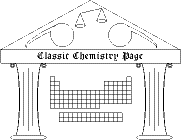Fajans displacement law
The discovery of radioactivity and the subsequent study of radioactive materials led to a proliferation of substances never before observed. Ernest Rutherford and Frederick Soddy proposed as early as 1902 that radioactive decay was accompanied by a chemical transformation of one element into another. About 10 years later, Soddy and Kasimir Fajans independently unraveled the pattern of transformations that accompanied α and β radioactive decay. In the process, they developed the concept of isotope (Soddy's term), which allowed for classification of the many new substances within the already existing framework of the periodic table.
Fajan's paper on the subject examined several radioactive decay chains, including the following, expressed in the confusing notation of the day:
| β[1] | | α | | α | | α | | α | | β | | α | | β
|
| Act | -- > | RadAct | -- > | ActX | -- > | ActEm | -- > | ActA | -- > | ActB | -- > | ActC | -- > | ActD | -- >
|
Write out this radioactive decay chain using modern notation for isotopes (AX, where A is the mass number and X the element symbol). The first term in the series ("Act") is 227Ac. The product of an α decay has two fewer neutrons and two fewer protons than before the decay (because an α particle is ejected, which consists of two protons and two neutrons). The product of a β decay has one more proton and one fewer neutron than before the decay (because in β decay, a neutron turns into a proton, which remains in the nucleus, and an electron and neutrino, which are ejected).
Reference
Kasimir Fajans, "Radioactive Transformations and the Periodic System of The Elements," Berichte der Deutschen Chemischen Gesellschaft 46, 422-439 (1913).
[1]The notation
denotes that Act turns into RadAct (whatever that is) with the release of a β particle.
Copyright 2003 by Carmen Giunta. Permission is granted to reproduce for non-commercial educational purposes.

| Back to the top of the Classic Chemistry site |